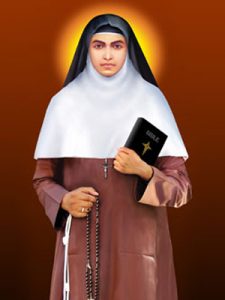Saints
| Saint Francis Xavier | ||
|---|---|---|
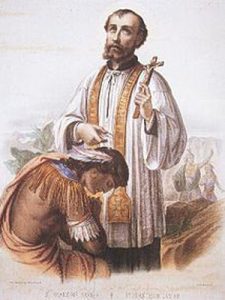 St. Francis Xavier |
||
| Place of Birth: | Spain | |
| State: | ||
| Date of Birth | 7 April 1506 | |
| Died On: | 3 December 1552 | |
| Blessed: | 25 October 1619 | |
| Canonized: | 12 March 1622 | |
| Buried at: | Goa | |
| Feast Day: | 3 December | |
St. Francis Xavier: Born to the nobility of the Basque reqion. Studied and taught philosophy at the University of Paris, and planned a career as a professor. Friend of Saint Ignatius of Loyola who convinced him to use his talents to spread the Gospel. One of the founding Jesuits, and the first Jesuit missionary. Priest. In Goa, India, while waiting to take ship, he preached in the street, worked with the sick, and taught children their catechism. He would walk through the streets ringing a bell to call the children to their studies. Said to have converted the entire city. He scolded his patron, King John of Portugal, over the slave trade: “You have no right to spread the Catholic faith while you take away all the country’s riches. It upsets me to know that at the hour of your death you may be ordered out of paradise.” Tremendously successful missionary for ten years in India, the East Indies, and Japan, baptizing more than 40,000 converts. His epic finds him dining with head hunters, washing the sores of lepers in Venice, teaching catechism to Indian children, baptizing 10,000 in a single month. He tolerated the most appalling conditions on long sea voyages, enduring extremes of heat and cold. Wherever he went he would seek out and help the poor and forgotten. He traveled thousands of miles, most on his bare feet, and he saw the greater part of the Far East. Had the gift of tongues. Miracle worker. Raised people from the dead. Calmed storms. Prophet. Healer.
| Saint Gonsalo Garcia | ||
|---|---|---|
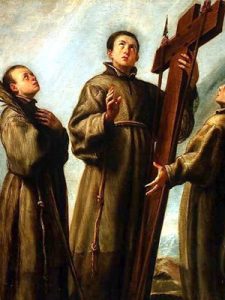 St. Gonsalo Garcia |
||
| Place of Birth: | Vasai | |
| State: | Maharashtra | |
| Date of Birth | 5 February 1557 | |
| Died On: | 5 February 1597 | |
| Blessed: | 14 September 1627 | |
| Canonized: | 8 June 1862 | |
| Buried at: | St. Gonsalo, Vasai | |
| Feast Day: | February 6 | |
Saint Gonsalo Garcia (1556–1597) is a First Roman Catholic saint from India. Born in the western coastal town of Vasai, an exurb of the city of Bombay, he preached from the Bassein fort during the time the town was under Portuguese colonial rule. The feast of St. Garcia has traditionally been held on the first Sunday nearest to the neap tide following Christmas in Vasai.
Gonsalo Garcia was born Gundi Slavus Garcia— to a Portuguese father and a Canarese (resident of the Konkan coast) mother in Bassein, on February 5, 1557. He was the right hand of father St. Peter Baptist Superior of Franciscan mission in Japan. He was tutored by Fr. Sebastian Gonsalves, a Jesuit priest working in Vasai, in the college near Bassein fort. Garcia studied under the tutelage of the Jesuits for eight years from 1564 to 1572.Then, at the age of fifteen, Fr. Sebastian took Garcia to Japan. He soon managed to learn the language and since was seen as an affable person; he soon became popular in the local community as a catechist. He resigned and left to Alcao to set up trade. His business prospered and branches were opened indifferent locales in Southeast Asia. Gonsalo's long cherished dream to be a Jesuit did not materialise and moved on to Manila in the Philippines as a lay missionary. In the Philippines, he was influenced by a Franciscan priest, Fr.Peter Baptista and soon joined the Seraphic Order as a lay brother. After working with the leprosy patients there he was formally ordained as a Franciscan as the Friars Minor at Manila.
On May 26, 1592, the Spanish governor in the Philippines sentGonsalo on a diplomatic mission back to Japan along with Baptista. Afterworking for four years, the Japanese shogun suspected the missionaries ofsedition and were placed under house arrest in their monastery in Miaco (Kyoto)on 8 December 1596. A few days afterwards, when they were singing vespers, theywere arrested, manacled and immured. On January 3, 1597, the left ears oftwenty-six confessors among them Garcia, were exscinded; but were thencollected in reverence by the local Christians. On February 5, Garcia wascrucified on Nagasaki Hills with twenty six of his companions. St. Garcia wasthe first to be extended on, and nailed to, the cross, which was then erectedin the middle of those of his companions. Fr. Gonsalo, the first to arrive,went straight to one of the crosses and asked "Is this mine?". Thereply was "It is not". Then he was taken to another cross, where heknelt down and embraced it. The others, one after another, started doing thesame. "That was quite a sight, the way Br. Philip was embracing his cross.. . " comments one of the witnesses. [3] Two lances impaled his bodythrough his heart. While being nailed, Garcia sang praises of God, earning himthe martyr's title.
In 1627, Garcia and his fellow martyrs were declared asVenerable by Pope Urban VIII. The martyr's feast day occurs on Feb 5th and in1629, their veneration was permitted throughout the Catholic Church. On June 8,1862 Garcia was declared a saint by Pope Pius IX. The Gonsalo Garcia Church inVasai was built in 1942 and renovated in 1957. A weeklong feast is celebratedthere in February in his honour. The church is tallest church in Vasai. It wasbuilt by Msgr. Louise Caitan D'souza a Goan priest.
| Saint John de Brito | ||
|---|---|---|
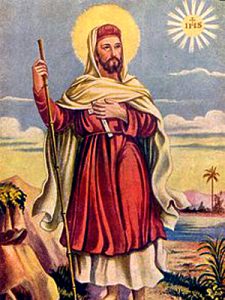 St. John de Brito |
||
| Place of Birth: | Lisbon, Portugal | |
| State: | ||
| Date of Birth | March 1, 1647 | |
| Died On: | February 11, 1693 | |
| Blessed: | August 21, 1853 | |
| Canonized: | June 22, 1947 | |
| Buried at: | Oriyur, Tamil Nadu | |
| Feast Day: | February 4 | |
Saint John de Brito: Born in Lisbon, Portugal, on March 1, 1647 – died at Oriyur, Tamil Nadu, India, on February 11, 1693) was a Portuguese Jesuit missionary and martyr, often called "the Portuguese St. Francis Xavier" by Indian Catholics. John de Brito was born in a Portuguese family. He joined the Jesuits in 1662. He traveled to the missions of Madura, in southern India, present-day Tamil Nadu, in 1673 and preached the Christian religion. He renamed himself Arul Anandar. Brito learned the native languages, went about dressed in yellow cotton and living like a Hindu Kshatriya and tried to teach the Catholic faith in categories and concepts that would make sense to the people he taught.
| Saint Alphonsa Muttathupadathu | ||
|---|---|---|
| Place of Birth: | Kudamaloor | |
| State: | Kerala | |
| Date of Birth | 19 August 1910 | |
| Died On: | 28 July 1946 | |
| Blessed: | 08/2/1986 | |
| Canonized: | 12/10/2008 | |
| Buried at: | Saint Alphonsa Catholic Church Bharananganam, Kottayam-686578, Kerala | |
| Feast Day: | 28th July | |
Saint Alphonsa Muttathupadathu, F.C.C., or Saint Alphonsa of the Immaculate Conception was a Catholic Franciscan Religious Sister who is now honored as a saint, the first person of Indian origin to be canonized as a saint by the Catholic Church and the first canonized saint of the Syro-Malabar Catholic Church, an Eastern Catholic Church of the Saint Thomas Christian community. She joined the Franciscan Clarist Congregation, the Third Order of St. Francis, and through them, completed schooling and made her permanent vows in 1936. She taught school for years but was plagued by illness.
| Saint Kuriakose Elias Chavara | ||
|---|---|---|
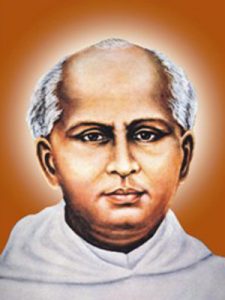 St. Kuriakose Elias Chavara |
||
| Place of Birth: | Kainakary | |
| State: | Kerala | |
| Date of Birth | February 10, 1805 | |
| Died On: | January 3, 1871 | |
| Blessed: | February 8, 1986 | |
| Canonized: | 23 November 2014 | |
| Buried at: | Mannanam | |
| Feast Day: | January 3 | |
St. Kuriakose Elias Chavara was born on 10th Feb. 1805 of God fearing parents Iko (Kuriakose) Chavara and Mariam Thoppil of the Syro-Malabar Church, at Kainakary, near Allappuzha, Kerala. According to the local custom the infant was baptized on the 8th day in Chennankari Parish Church, Alappuzha. From the age 5 to 10, he attended the village school (Kalari) to study languages, different dialects, and elementary sciences under the guidance of a Hindu teacher (Asan). Inspired by the desire to become a priest, he began the studies under the parish priest of the church of St. Joseph. At the age of 13 in 1818 he entered the seminary at Pallipuram where Malpan Thomas Palackal was the Rector. He was ordained priest on 29th November, 1829 at Arthunkal and celebrated his First Holy Mass at Chennankari Church. After the ordination he was engaged for some time in pastoral ministry; however he soon returned to the seminary to teach and also to officiate for the Malpan Thomas Palackal during his absence. Thus he joined Malpan Thomas Porukara and Malpan Thomas Palackal when they were planning to found a congregation.
In 1830 he went to Mannanam to direct the construction of the first house of the congregation of which the foundation stone was laid on 11th May, 1831. After the death of both the Malpans, St. Chavara took up leadership. On 8th December, 1855 he made the religious profession along with other 10 companions, under the name "Kuriakose Elias of Holy Family". He was the Prior General of all the monasteries of the congregation from 1856 till his death in 1871. When, in 1861, a schism threatened the Church of Kerala with the arrival of Mar Thomas Rokos without proper credentials from the Pope, St. Chavara was appointed the Vicar-General of the Syro-Malabar Church by the Arch-Bishop of Verapolly. St. Chavara is gratefully remembered and acknowledged by the later leaders of the Church and by the Catholic community in general for his strenuous fight, strong stance , and effective leadership in thwarting `Thomas Rochos' intrusion and saving the church of Kerala from schism.
In 1871, on January 3rd, Fr. Kuriakose Elias Chavara, with a painful illness, died at Koonammavu monastery in Kochi, preserving his baptismal innocence. His mortal remains were later transferred from Koonammavu to Mannanam in 1889 and are piously kept in the St. Joseph's Monastery church.
| Saint Saint Teresa of Calcutta | ||
|---|---|---|
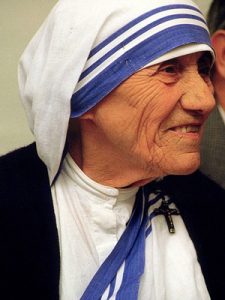 |
||
| Place of Birth: | Skopje Macedonia | |
| State: | West Bengal | |
| Date of Birth | 26 August 1910 | |
| Died On: | 5 September 1997 | |
| Blessed: | 19 October 2003 | |
| Canonized: | 4 September 2016 | |
| Buried at: | Kolkotta | |
| Feast Day: | 5 September | |
Mother Teresa was born Agnes Gonxha Bojaxhiu in Skopje, Macedonia, on August 26, 1910. Her family was of Albanian descent. At the age of twelve, she felt strongly the call of God. She knew she had to be a missionary to spread the love of Christ. At the age of eighteen she left her parental home in Skopje and joined the Sisters of Loreto, an Irish community of nuns with missions in India. After a few months' training in Dublin she was sent to India, where on May 24, 1931, she took her initial vows as a nun. From 1931 to 1948 Mother Teresa taught at St. Mary's High School in Calcutta, but the suffering and poverty she glimpsed outside the convent walls made such a deep impression on her that in 1948 she received permission from her superiors to leave the convent school and devote herself to working among the poorest of the poor in the slums of Calcutta. Although she had no funds, she depended on Divine Providence, and started an open-air school for slum children. Soon she was joined by voluntary helpers, and financial support was also forthcoming. This made it possible for her to extend the scope of her work. On October 7, 1950, Mother Teresa received permission from the Holy See to start her own order, "The Missionaries of Charity", whose primary task was to love and care for those persons nobody was prepared to look after. In 1965 the Society became an International Religious Family by a decree of Pope Paul VI. Today the order comprises Active and Contemplative branches of Sisters and Brothers in many countries. In 1963 both the Contemplative branch of the Sisters and the Active branch of the Brothers was founded. In 1979 the Contemplative branch of the Brothers was added, and in 1984 the Priest branch was established. Mother Teresa's work has been recognised and acclaimed throughout the world and she has received a number of awards and distinctions, including the Pope John XXIII Peace Prize (1971) and the Nehru Prize for her promotion of international peace and understanding (1972). She also received the Balzan Prize (1979) and the Templeton and Magsaysay awards. On Oct. 19, 2003, Pope John Paul II beatified Mother Teresa of Calcutta, who died in 1997.
| Saint Euphrasia Eluvathingal | ||
|---|---|---|
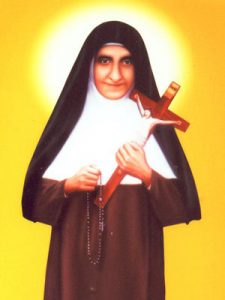 St. Euphrasia |
||
| Place of Birth: | Irinjalakuda | |
| State: | Kerala | |
| Date of Birth | 17 October 1877 | |
| Died On: | 29 August 1952 | |
| Blessed: | 3 December 2006 | |
| Canonized: | 23 November 2014 | |
| Buried at: | Ollur | |
| Feast Day: | 29 August | |
St. Euphrasia of the Sacred Heart of Jesus, C.M.C., was an Indian Carmelite Religious Sister of the Syro-Malabar Church.
Euphrasia Eluvathingal was born on October 17, 1877, in the village of Kattur, in Syro-Malabar Catholic Archdiocese of Thrissur in Thrissur district. Rosa was the eldest child of Eluvathingal Cherpukaran Antony and Kunjethy. On the 8th day, she was baptised in the Edathuruthy church. At the age of 12th, she joined boarding attached to the first indigenous Carmelite community founded by St. Kuriakose Elias Chavara and Rev. Leopold.
St. Euphrasia entered the convent in Koonammavu, at the age of ten. She endeavored to lead a life of constant prayer and of devotion to the Sacred Heart of Jesus, constantly trying to atone for the sins committed against him, becoming known by many people as the "Praying Mother. She spent much of her day in the convent chapel before the St. Sacrament, to which she had a strong devotion.
She also nourished a great love and devotion for the St. Virgin Mary, as a result of which, she would promote devotion to the Eucharist and to the Rosary to all those with whom she came into contact.
| Blessed Joseph Vaz | ||
|---|---|---|
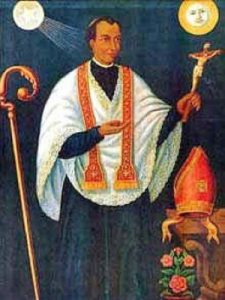 Blessed Joseph Vaz |
||
| Place of Birth: | Benaulim | |
| State: | West Bengal | |
| Date of Birth | 21 April 1651 | |
| Died On: | 16 January 1711 | |
| Blessed: | 21 January 1995 | |
| Canonized: | ||
| Buried at: | ||
| Feast Day: | ||
Blessed Joseph Vaz, (21 April 1651, Benaulim – 16 January 1711, Kandy) was a Catholic Oratorian Priest from Goa. He is known as the 'Apostle of Ceylon'. Fr. Vaz entered Sri Lanka during the Dutch occupation, when Calvinism was the official religion. He travelled throughout the island bringing the Eucharist and the sacraments to clandestine groups of Catholics. Later in his mission, he found shelter in the Kandyan kingdom where he was able to work freely. At the time of his death, Fr. Vaz managed to rebuild the Catholic church on the island.
| Saint Maria Theresa Chiramel | ||
|---|---|---|
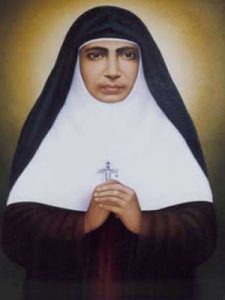 Bl. Mariam Thresia Chiramel |
||
| Place of Birth: | Kuzhikattussery | |
| State: | Kerala | |
| Date of Birth | 26 April 1876 | |
| Died On: | 8 June 1926 | |
| Blessed: | 9 April 2000 | |
| Canonized: | 13 October 2019 | |
| Buried at: | Kuzhikkattuserry | |
| Feast Day: | 8 June | |
Blessed Maria Theresa Chiramel is a Holy Family nun from Kerala in Thrissur, beatified in 2000. She is the founder of the Holy Family Congregation.
Maria was born in Puthenchira in Thrissur district on April 26, 1876 as the third child of Thoma and Thanda Chiramel Mankidiyan. She was baptized as Thresia Chiramel Mankidiyan on May 3, 1876. When she was 12 her mother died. This marked the end of her elementary school education and dedicated herself to prayer in her church.
Maria served several religious congregations and in 1913, she set up a prayer house at Puthenchira and in the next year she founded her Holy Family Congregation on May 14, 1914. She died at Kuzhikattussery, Thrissur district on June 8, 1926.
She was declared Servant of God on October 5, 1973; declared Venerable on June 28, 1999 by Pope John Paul II and w as Blessed on April 9, 2000 by Pope John Paul II.

